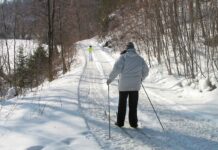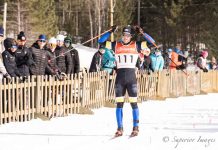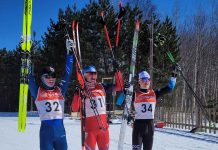

THUNDER BAY – Healthbeat – Long distance skiers are usually considered to be at the top of their game in terms of fitness. However new research is suggesting there could be dangers from the sport. The study, a first into nordic skiing was released today.
Cross-country skiers who take part in one of the world’s most challenging ski races, the 90 km Vasaloppet in Sweden, are at increased risk of developing arrhythmia – problems with the rate or rhythm of their heart beat – according to a study of nearly 53,000 race participants published online today (Wednesday) in the European Heart Journal [1].
Cross Country Skiers face heart risk
The risk of developing atrial fibrillation (an irregular or abnormally fast heart beat) or bradyarrhythmias (a heart beat that is too slow) was greater among skiers who completed a higher number of races and with a faster finishing time relative to other participants.
Dr Kasper Andersen, a cardiologist at Uppsala University Hospital (Uppsala, Sweden), said: “We found that those who completed five or more races in a period of ten years, had a 30% higher risk of developing any arrhythmia than those who did one race only. Similarly, skiers who had the fastest finishing time relative to the other participants also had a 30% higher risk of developing any arrhythmia in subsequent years.”
Dr Andersen and his colleagues identified 52,755 cross-country skiers who had completed the Vasaloppet between 1989-1998, and followed them through to 2005 [2]. During this follow-up period, 919 participants experienced some form of arrhythmia (1.74% of the total number of participants).
Dr Andersen said the study was important because, although there have been other studies looking at the effects of endurance exercise on various cardiovascular problems such as ischemic heart disease and stroke, there have been only a few, smaller studies of its effect on heart rhythm disturbances, and they have tended to look at people who are less physically active, or compared very sedentary people with those who were very active.
“The present study investigates the higher end of the physical activity level scale and shows how very high physical activity level affects risk of arrhythmias. The skiers in our study are as a group healthier than the general population. We have previously shown that besides higher leisure time physical activity, the participants in Vasaloppet smoke less, have lower fat and higher fibre consumption and better physical and mental health than the general population. Actually the participants have about half the mortality than the general population. This is probably not only because of the training level of the participants, but also because the participants need to be healthy to even consider participating in the race,” he said.
The researchers used the number of finished races and the finishing time as measures of the participants’ duration and intensity of physical exercise. They divided the finishing times into four groups, representing percentages of the winning time that year, where the fastest finishing time is a 100% and the slowest times more than 240%. Similarly, the number of races each person completed was categorised into four groups: one race, two races, three to four races, and five or more races.
After adjusting for confounding factors such as age, education and occupational status, the researchers found that not only was there a 30% increased risk of any arrhythmia with the highest number of races completed and the fastest finishing time, but also the risk increased by 10% between each category for the number of races completed, i.e. there was a 10% increased risk from the least exposed group of participants (those who completed only one race) to the next group (two races), another 10% increase in risk to the next group (three-four races) and another 10% to the most exposed group (five or more races).
There was a similar, but statistically non-significant trend in increased risk between each category for the finishing times, with a 6% increased risk between the slowest finishing times and the next group.
“These findings suggest there is a dose-response relationship: the more races skiers complete and the faster they go, the greater their risk of subsequently developing arrhythmia,” said Dr Andersen. “However, it is important to stress that this study does not show that the exercise causes arrhythmias, only that it is associated with an increased risk.”
When they looked at the different types of arrhythmia, the researchers found that the most frequent was atrial fibrillation, which occurred in 681 skiers. After adjusting for age, education and occupation, there was a 29% increased risk of AF among skiers completing five or more races compared to those completing only one; there was a 20% higher incidence of AF for those with the fastest finishing times compared to the slowest, although this finding was not statistically significant.
Bradyarrhythmia occurred in 119 skiers. After adjusting for age, education and occupation, the risk more than doubled (110% increase) among those who completed five or more races compared with those who completed one. There was a tendency for the risk to increase with faster finishing times (85% increased risk between the slowest and fastest), but this finding was not statistically significant.
“It is important to emphasise that numerous studies have shown that exercise protects against heart disease and numerous other diseases,” said Dr Andersen. “Our findings should not deter people from exercising, especially as we did not find any increased incidence of arrhythmias leading to sudden death. We have shown previously that Vasaloppet participants are less likely to die during the follow-up period than the general population and that mortality decreases with increasing numbers of races. This has also been shown in a Dutch long-distance skating event. Therefore, we believe that it is generally safe to prepare for and participate in the Vasaloppet races.” [3]
Notes:
[1] “Risk of arrhythmias in 52 755 long-distance cross-country skiers: a cohort study”, by Kasper Andersen, Bahman Farahmand, Anders Ahlbom, Claes Held, Sverker Ljunghall, Karl Michaëlsson, and Johan Sundström.European Heart Journal. doi:10.1093/eurheartj/eht188.
[2] The Vasoloppet is the world’s oldest, longest, and largest cross-country skiing race.
[3] “Mortality amongst participants in Vasaloppet: a classical long-distance ski race in Sweden”, by B,Y. Farahmand, A. Ahlbom, O. Ekblom, B. Ekblom, U. Hållmarker, D. Aronson, G.P. Brobert. Journal of Internal Medicine2003 March; 253(3): 276-83.













